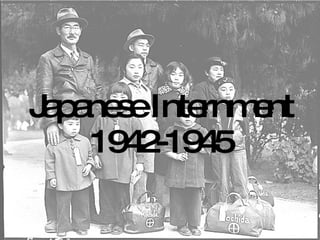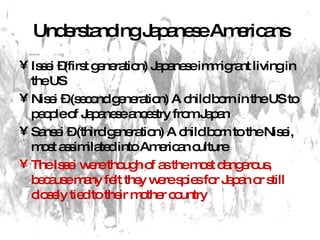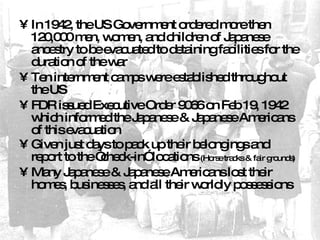Japanese Internment
- 2. Understanding Japanese Americans Issei â(first generation) Japanese immigrant living in the US Nisei â (second generation) A child born in the US to people of Japanese ancestry from Japan Sansei â (third generation) A child born to the Nisei, most assimilated into American culture The Issei were though of as the most dangerous, because many felt they were spies for Japan or still closely tied to their mother country
- 3. In 1942, the US Government ordered more then 120,000 men, women, and children of Japanese ancestry to be evacuated to detaining facilities for the duration of the war Ten internment camps were established throughout the US FDR issued Executive Order 9066 on Feb 19, 1942 which informed the Japanese & Japanese Americans of this evacuation Given just days to pack up their belongings and report to the âcheck-inâ locations (Horse tracks & fair grounds) Many Japanese & Japanese Americans lost their homes, businesses, and all their worldly possessions
- 4. Ėý
- 5. Manzanar Located in Owens Valley 4,000â elevation in the Sierra Nevada Mts. Summer time temperatures over 100 °F Winter time temperatures average around 40°F Year round nighttime temperatures 30-40°F
- 6. In 1942, the US Army leased 6,200 acres from the city of Los Angeles to build the detainment facility at Manzanar Although some residents of the Owens Valley may have opposed this construction, many helped build and work in the facility during the war Japanese resentment continued to build as more Japanese & Japanese Americans were forced to leave their homes "I am for the immediate removal of every Japanese on the West Coast to a point deep in the interior. I don't mean a nice part of the interior either. Herd 'em up, pack 'em off and give 'em the inside room in the badlands. Personally, I hate the Japanese. And that goes for all of them." "A viper is nonetheless a viper whenever the egg is hatched - so a Japanese American, born of Japanese parents - grows up to be a Japanese, not an American."
- 7. Ėý
- 8. Housing Camps were enclosed with barbed wire and several watch towers Camps were build quickly during the summer of 1942 so not much detail or planning went into their construction Residences were long 100âx 20â military style barracks, this was then divided into four âhomesâ Each 20âx25â room housed 8-9 people with eight cots 7âx3â leaving very little space for anything else
- 9. Life in the Interment Camps Families lived in unsanitary conditions (open sewers), communal toilet and bathing facilities Japanese âinmatesâ stood in line for everything: meals, latrines, supplies, and services Meals were nutritionally inadequate Medical care was minimal Children did attend school (where they pledged allegiance to the American flag every morning) Adults worked in the camp offices, mess halls, schools, hospitals, and war time production facilities For their work, adults earned $8-$16 per month for their 44 hour work week, paid in scrip so they could only use the money to buy things within the camp









